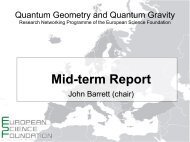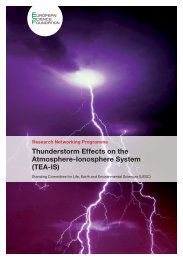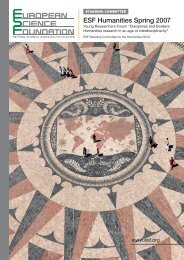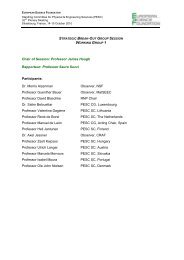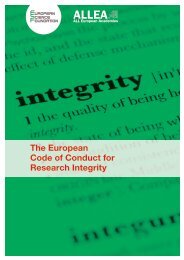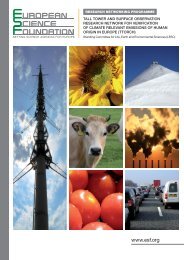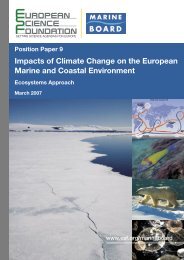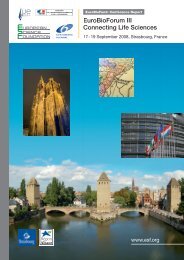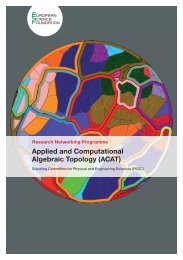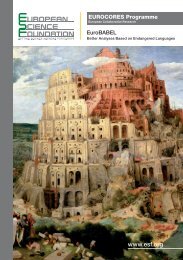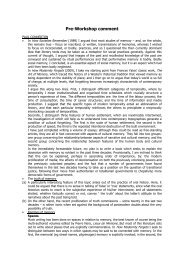EuroSCOPE Final Report - European Science Foundation
EuroSCOPE Final Report - European Science Foundation
EuroSCOPE Final Report - European Science Foundation
Create successful ePaper yourself
Turn your PDF publications into a flip-book with our unique Google optimized e-Paper software.
5. ConclusionsThe Review Panel (RP) conducted a written assessmentof the <strong>EuroSCOPE</strong> Programme in general and specificallythe submitted final reports of the CRPs. At the finalmeeting with the RP, the Project Leaders also presentedthe outcome of their CRPs and looked forward to futureinitiatives. The presentations were followed by a discussionwith the panel.With regards to the organisational aspects of theProgramme, the RP specifically commented that thesubcritical mass of participating <strong>European</strong> countries thatwere supporting the programme was a major drawback.The original Programme was designed to cover a broadrange of topics having various subfields and multiplecalls for proposals. In practice, the Programme had to bereduced in its scope and ambition in order to comply withthe limited amount of funding that was committed.Initially, the Programme suffered from a rather long reviewingprocedure (2004-2006) followed by a time delaybefore the start of funding for the CRPs. This was consideredas a start-up problem for the newly developedEUROCORES Programme Scheme, and current improvementsof the Scheme should ensure that such delays atthe preparatory stage can be avoided in future.The RP members also indicated that they would havepreferred to be more closely involved in the networkingand dissemination activities of the Programme.In terms of scientific achievements the <strong>EuroSCOPE</strong>Programme delivered a series of valuable outputs. Asa main highlight the RP mentioned the optimisation ofB. subtilis production system for efficient expression ofcomplex membrane proteins. The Programme has alloweda number of <strong>European</strong> scientists to maintain andextend their leadership in the field of B. subtilis research.Moreover, the consortium demonstrated its ability tocreate synergism by bringing together complementaryfunding schemes from across Europe.The proof of principle for the use of the Picchia pastorissystem for improved production of complex proteinshas been delivered. As an important spin-off from theprogramme, the RP mentioned the possibility of “knowledgetransfer” to industrial partners in relation to thehypoxic batchfed system.A novel chaperone required for specific protein complexassembly was identified, underlining the need forthe identification and potential exploitation of specialisedcellular components in some cases.For the whole Programme transnational scientific collaborationwas demonstrated by a respectable list ofhigh-quality co-authored research publications.Networking, training and dissemination was performedat a satisfactory level. Personnel exchange and trainingwas good within the different CRPs. The set-up andobjectives of the different CRPs did not lend itself tosignificant exchanges of personnel between CRPs. Itwas recommended that in future there should be moreinter-CRP exchange to enable participants to access newtechnologies and approaches that might be beneficialfor their work.18 | <strong>EuroSCOPE</strong> – <strong>Science</strong> of Protein Production for Functional and Structural Analysis



